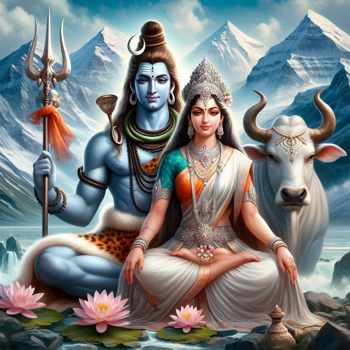-
Symbol of Marital Harmony: The Gaurishankar Puja signifies the ideal marital relationship between Lord Shiva and Goddess Parvati, symbolizing love, commitment, and understanding between couples.
-
Spiritual Unity: The worship of Gauri and Shankar represents the union of the soul (Atma) with the Supreme (Paramatma), making it a powerful ritual for those seeking spiritual growth and enlightenment.
-
Fulfillment of Desires: Devotees believe that sincere prayers during this puja can fulfill personal desires, particularly those related to marriage, health, and prosperity.
-
Removal of Obstacles: The puja is known to remove obstacles in one's personal and professional life, ensuring a smooth and successful journey.
-
Enhancement of Relationships: It is believed to strengthen relationships, not only between husband and wife but also among family members, fostering love and unity.
- Brings marital harmony and happiness in relationships.
- Enhances spiritual growth and deepens the connection with the divine.
- Helps in overcoming obstacles in life, leading to success and prosperity.
- Fulfills desires related to marriage, health, and overall well-being.
- Promotes peace and unity within the family and community.
- Provides protection from negative energies and evil influences.
Gaurishankar Puja is a revered Hindu ritual that involves the worship of Lord Shiva (Shankar) and Goddess Parvati (Gauri). This puja is often performed by couples seeking marital harmony or by those desiring a good life partner. Below is a step-by-step guide to performing Gaurishankar Puja:
Preparation
-
Choose an Auspicious Day:
- Perform the puja on a Monday, during the month of Shravan (July-August), or during a Shivratri, as these are considered auspicious for worshiping Lord Shiva and Goddess Parvati.
-
Gather Puja Items:
- Idols or Images: Idols or pictures of Lord Shiva and Goddess Parvati.
- Puja Thali: A metal plate to hold the offerings.
- Panchamrit: A mixture of milk, yogurt, honey, sugar, and ghee.
- Flowers and Leaves: Especially bel (bilva) leaves, lotus, marigold, and hibiscus flowers.
- Incense Sticks and Camphor: For fragrance and purification.
- Fruits and Sweets: To offer as naivedyam.
- Red and White Cloth: For Goddess Parvati and Lord Shiva, respectively.
- Akshat (Rice): Mixed with turmeric for offering.
- Ghee Lamp: A diya (lamp) to light during the puja.
- Kumkum (vermilion), Haldi (turmeric), Sandalwood Paste: For tilak and other rituals.
- Water Pot: For Abhishek (ritual bathing).
- Betel Leaves and Nuts: For offering.
- Sacred Thread (Kalava): For tying during the puja.
Puja Procedure
-
Purify Yourself:
- Take a bath early in the morning and wear clean, preferably white, clothes.
-
Prepare the Puja Area:
- Clean the area where the puja will be performed.
- Spread a clean cloth or mat on the floor.
- Place the idols or images of Lord Shiva and Goddess Parvati on a raised platform covered with a red and white cloth.
-
Invoke the Deities:
- Sit facing East or North.
- Light the diya and incense sticks.
- Close your eyes and meditate, invoking the presence of Lord Shiva and Goddess Parvati.
-
Kalash Sthapana (Establishing the Pot):
- Fill a copper or brass pot with water, place a coconut on top, and surround it with mango leaves.
- Place the Kalash in front of the deities, symbolizing their divine presence.
-
Panchamrit Abhishek (Bathing the Deities):
- Offer water to the deities, followed by Panchamrit (mixture of milk, yogurt, honey, sugar, and ghee).
- After bathing, clean the idols with fresh water and wipe them with a clean cloth.
-
Offerings:
- Apply sandalwood paste, kumkum, and haldi to the idols.
- Offer fresh flowers, especially bel leaves, lotus, and marigold.
- Place fruits, sweets, and betel leaves with nuts in front of the deities.
- Offer Akshat (turmeric-mixed rice) while chanting mantras.
-
Chant Mantras:
- Recite the Shiva Mantra: "Om Namah Shivaya" or Mahamrityunjaya Mantra.
- Recite the Parvati Mantra: "Om Gauri Shankaraya Namah".
- You can also chant other mantras specific to Gaurishankar Puja.
-
Perform Aarti:
- Light the camphor and perform the aarti by rotating the thali in front of the deities.
- Sing the Shiva aarti and other hymns praising Lord Shiva and Goddess Parvati.
-
Pradakshina and Prayers:
- Perform a circumambulation (Pradakshina) around the deities, usually three times.
- Offer prayers, seeking blessings for marital harmony, good fortune, and fulfillment of wishes.
-
Tie the Sacred Thread (Kalava):
- Tie the sacred thread on your wrist or around the deity, symbolizing your bond with the divine.
-
Conclusion:
- After the aarti, distribute the prasad (blessed food) among family members.
- Offer the leftover water from the Kalash to a sacred plant like Tulsi or pour it at the roots of a tree.
Post-Puja:
- Sit quietly for a few minutes, reflecting on the puja and the blessings sought.
- Clean up the puja area respectfully.
- Continue to honor Lord Shiva and Goddess Parvati by following their teachings in your daily life.
This puja, when done with devotion, is believed to bring peace, harmony, and blessings from the divine couple.




